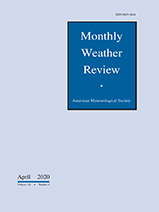Northeast Alabama Terrain Findings
A Background Investigation of Tornado Activity across the Southern Cumberland Plateau Terrain System of Northeastern Alabama
Anthony W. Lyza and Kevin R. Knupp
https://doi.org/10.1175/MWR-D-18-0300.1

Abstract
The effects of terrain on tornadoes are poorly understood. Efforts to understand terrain effects on tornadoes have been limited in scope, typically examining a small number of cases with limited observations or idealized numerical simulations. This study evaluates an apparent tornado activity maximum across the Sand Mountain and Lookout Mountain plateaus of northeastern Alabama. These plateaus, separated by the narrow Wills Valley, span ~5000 km2 and were impacted by 79 tornadoes from 1992 to 2016. This area represents a relative regional statistical maximum in tornadogenesis, with a particular tendency for tornadogenesis on the northwestern side of Sand Mountain. This exploratory paper investigates storm behavior and possible physical explanations for this density of tornadogenesis events and tornadoes. Long-term surface observation datasets indicate that surface winds tend to be stronger and more backed atop Sand Mountain than over the adjacent Tennessee Valley, potentially indicative of changes in the low-level wind profile supportive to storm rotation. The surface data additionally indicate potentially lower lifting condensation levels over the plateaus versus the adjacent valleys, an attribute previously shown to be favorable for tornadogenesis. Rapid Update Cycle and Rapid Refresh model output indicate that Froude numbers for the plateaus in tornadic environments are likely supportive of enhanced low-level flow over the plateaus, which further indicates the potential for favorable wind profile changes for tornado production. Examples of tornadic storms rapidly acquiring increased low-level rotation while reaching the plateaus of northeast Alabama are presented. The use of this background to inform the VORTEX-SE 2017 field campaign is discussed.
Observed Near-Storm Environment Variations across the Southern Cumberland Plateau System in Northeastern Alabama
Anthony W. Lyza, Todd A. Murphy, Barrett T. Goudeau, Preston T. Pangle, Kevin R. Knupp, and Ryan A. Wade
https://doi.org/10.1175/MWR-D-19-0190.1

Abstract
The Sand Mountain and Lookout Mountain Plateaus in northeastern Alabama have been established as a regional relative maximum in tornadogenesis reports within the southeastern United States. Investigation of long-term surface datasets has revealed (i) stronger and more backed winds atop Sand Mountain than over the Tennessee Valley, and (ii) measured cloud-base heights are lower to the surface atop Sand Mountain than over the Tennessee Valley. These observations suggest that low-level wind shear and lifting condensation level (LCL) height changes may lead to conditions more favorable for tornadogenesis atop the plateaus than over the Tennessee Valley. However, prior to fall 2016, no intensive observations had been made to further investigate low-level flow or thermodynamic changes in the topography of northeastern Alabama. This paper provides detailed analysis of observations gathered during VORTEX-SE field campaign cases from fall 2016 through spring 2019. These observations indicate that downslope winds form along the northwest edge of Sand Mountain in at least some severe storm environments in northeastern Alabama. Wind profiles gathered across northeastern Alabama indicate that low-level helicity changes can be substantial over small distances across different areas of the topographic system. LCL height changes often scale to changes in land elevation, which can be on the order of 200–300 m across northeastern Alabama.
Terrain and Surface Roughness Findings
The Empirical Dependence of Tornadogenesis on Elevation Roughness: Historical Record Analysis Using Bayes’s Law in Arkansas
Zhanxiang Hua and Daniel R. Chavas
https://doi.org/10.1175/JAMC-D-18-0224.1

Abstract
Recent research suggests that surface elevation variability may influence tornado activity, though separating this effect from reporting biases is difficult to do in observations. Here we employ Bayes’s law to calculate the empirical joint dependence of tornado probability on population density and elevation roughness in the vicinity of Arkansas for the period 1955–2015. This approach is based purely on data, exploits elevation and population information explicitly in the vicinity of each tornado, and enables an explicit test of the dependence of results on elevation roughness length scale. A simple log-link linear regression fit to this empirical distribution yields an 11% decrease in tornado probability per 10-m increase in elevation roughness at fixed population density for large elevation roughness length scales (15–20 km). This effect increases by at least a factor of 2 moving toward smaller length scales down to 1 km. The elevation effect exhibits no time trend, while the population bias effect decreases systematically in time, consistent with the improvement of reporting practices. Results are robust across time periods and the exclusion of EF1 tornadoes and are consistent with recent county-level and gridded analyses. This work highlights the need for a deeper physical understanding of how elevation heterogeneity affects tornadogenesis and also provides the foundation for a general Bayesian tornado probability model that integrates both meteorological and nonmeteorological parameters.
